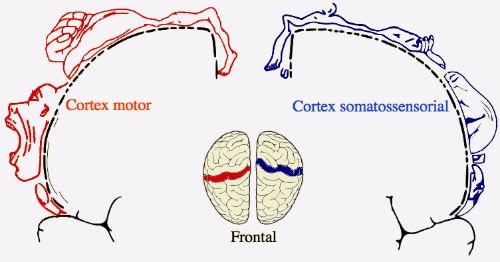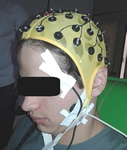Neuroengineering
Our research are focused on investigating the neural processing associated with motor control, learning and neural plasticity. Our main goal is to use such knowledge as the foundation for the development of novel assistive systems for disabled people. These new assistive systems can be achieved through novel strategies to support the rehabilitation of cognitive and neuromotor disorders or by developing brain-machine interfaces for communication, locomotion and prosthetic devices.
Decoding of movement intention and speech patterns based on connectivity analysis of cortical activity
 This project aims at developing and implementing novel methods for decoding cortical activity, focusing on assistive mechanisms for people with severe motor disabilities. Specifically, we are developing models and methods for analyzing dynamic cortical activity that is associated with the execution or imagination of two motor tasks: Speech production and voluntary upper-limb movements. Such models should be implemented aiming the development of brain-machine interfaces (BMI) to aid communucation, mobility and daily-life activities of people with severe motor disabilities caused by traumas or neurodegenerative diseases such as Lateral Amyotrophic Sclerosis (ALS).
This project aims at developing and implementing novel methods for decoding cortical activity, focusing on assistive mechanisms for people with severe motor disabilities. Specifically, we are developing models and methods for analyzing dynamic cortical activity that is associated with the execution or imagination of two motor tasks: Speech production and voluntary upper-limb movements. Such models should be implemented aiming the development of brain-machine interfaces (BMI) to aid communucation, mobility and daily-life activities of people with severe motor disabilities caused by traumas or neurodegenerative diseases such as Lateral Amyotrophic Sclerosis (ALS).
Researchers:
- Prof. Alcimar B Soares
- Dhainner R Macedo
- Mariana C Melo
- Andrei N Silva
Motor learning, neuroplasticity and rehabilitation of central nervous system (CNS) diseases
 Motor learning is a complex task comprised of different stages, involving many factors and mechanisms such as the type of practice and its conditions, memory, plasticity, decision making, adaptation, motivation and transfer of skills.
Motor learning is a complex task comprised of different stages, involving many factors and mechanisms such as the type of practice and its conditions, memory, plasticity, decision making, adaptation, motivation and transfer of skills.
This research is focused on investigating strategies to improve motor learning with clinical purposes. Our goal is to elaborate novel methods that can support and improve recovery during sensorimotor rehabilitation.
Researchers:
- Prof. Alcimar B Soares
- Maristella B Silva
- Débora Vieira
Neurobehavioral patterns of sleep bruxism
 We investigate the hypothesis that sleep bruxers present a different pattern of cortical activity during daytime. Sleep bruxism is an intense manifestation of rhythmic masticatory muscle activity (RMMA), characterized by teeth grinding and jaw clenching during sleep. Its non-defined etiology difficults the diagnosis and, therefore, the treatment plan. Etiological hypothesis point to an expressive participation from the central nervous system at the event's origin, specially from the limbic system, the autonomous nervous system and vago-trigeminal reflex. We are examining the relationship between cortical activity in awake subjects by means of EEG and visually evoked potentials and the intensity of RMMA during sleep.
We investigate the hypothesis that sleep bruxers present a different pattern of cortical activity during daytime. Sleep bruxism is an intense manifestation of rhythmic masticatory muscle activity (RMMA), characterized by teeth grinding and jaw clenching during sleep. Its non-defined etiology difficults the diagnosis and, therefore, the treatment plan. Etiological hypothesis point to an expressive participation from the central nervous system at the event's origin, specially from the limbic system, the autonomous nervous system and vago-trigeminal reflex. We are examining the relationship between cortical activity in awake subjects by means of EEG and visually evoked potentials and the intensity of RMMA during sleep.
Researchers:
- Prof. Alcimar B Soares
- Marila R Azevedo



 This project aims at developing and implementing novel methods for decoding cortical activity, focusing on assistive mechanisms for people with severe motor disabilities. Specifically, we are developing models and methods for analyzing dynamic cortical activity that is associated with the execution or imagination of two motor tasks: Speech production and voluntary upper-limb movements. Such models should be implemented aiming the development of brain-machine interfaces (BMI) to aid communucation, mobility and daily-life activities of people with severe motor disabilities caused by traumas or neurodegenerative diseases such as Lateral Amyotrophic Sclerosis (ALS).
This project aims at developing and implementing novel methods for decoding cortical activity, focusing on assistive mechanisms for people with severe motor disabilities. Specifically, we are developing models and methods for analyzing dynamic cortical activity that is associated with the execution or imagination of two motor tasks: Speech production and voluntary upper-limb movements. Such models should be implemented aiming the development of brain-machine interfaces (BMI) to aid communucation, mobility and daily-life activities of people with severe motor disabilities caused by traumas or neurodegenerative diseases such as Lateral Amyotrophic Sclerosis (ALS).  We investigate the hypothesis that sleep bruxers present a different pattern of cortical activity during daytime. Sleep bruxism is an intense manifestation of rhythmic masticatory muscle activity (RMMA), characterized by teeth grinding and jaw clenching during sleep. Its non-defined etiology difficults the diagnosis and, therefore, the treatment plan. Etiological hypothesis point to an expressive participation from the central nervous system at the event's origin, specially from the limbic system, the autonomous nervous system and vago-trigeminal reflex. We are examining the relationship between cortical activity in awake subjects by means of EEG and visually evoked potentials and the intensity of RMMA during sleep.
We investigate the hypothesis that sleep bruxers present a different pattern of cortical activity during daytime. Sleep bruxism is an intense manifestation of rhythmic masticatory muscle activity (RMMA), characterized by teeth grinding and jaw clenching during sleep. Its non-defined etiology difficults the diagnosis and, therefore, the treatment plan. Etiological hypothesis point to an expressive participation from the central nervous system at the event's origin, specially from the limbic system, the autonomous nervous system and vago-trigeminal reflex. We are examining the relationship between cortical activity in awake subjects by means of EEG and visually evoked potentials and the intensity of RMMA during sleep.